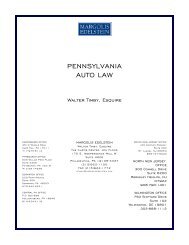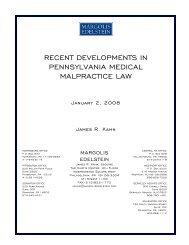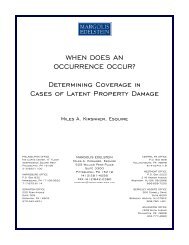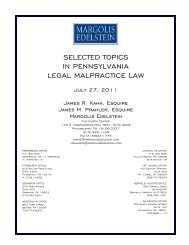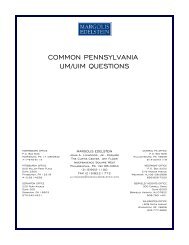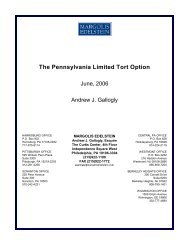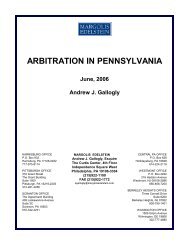Commercial General Liability Coverage Exclusions Under
Commercial General Liability Coverage Exclusions Under
Commercial General Liability Coverage Exclusions Under
Create successful ePaper yourself
Turn your PDF publications into a flip-book with our unique Google optimized e-Paper software.
Note: The “Occurrence” Requirement as an Alternative Basis for the Denial of <strong>Coverage</strong> for<br />
Property Damage Resulting from Faulty Workmanship or Construction Defects.<br />
Although it involves a subject beyond the topic of CGL policy exclusions, it should be noted<br />
that there is a potential alternative basis for the denial of many faulty workmanship and construction<br />
defect claims in Pennsylvania, including some which would otherwise fall outside the scope of the<br />
previous policy exclusions or within their exceptions, based upon the Insuring Agreement language<br />
stating that any “property damage” must be caused by an “occurrence”, a term defined as meaning<br />
an “accident”.<br />
Briefly, the Pennsylvania courts have recognized that commercial liability policies are<br />
intended to apply to tort claims where an insured’s work or product has caused accidental injury to<br />
another person or other property, but are not intended to guaranty the quality of the insured’s work<br />
product. It has repeatedly been held that faulty workmanship and defective product claims are<br />
essentially contractual in character even when they are couched in terms of negligence, and are not<br />
the intended subject of insurance coverage, at least where the alleged damage involves the insured’s<br />
own work or product itself. CGL policies, it has been said, are not the equivalent of performance<br />
bonds, and claims premised upon an insured’s poor performance of its contractual undertakings do<br />
not constitute an “occurrence” for coverage purposes, even when it is claimed that an insured was<br />
negligent. See, e.g., Ryan Homes v. The Home Indemnity Co., 647 A.2d 939 (Pa.Super. 1994),<br />
appeal denied, 657 A.2d 491 (Pa. 1995); Toombs NJ, Inc. v. Aetna Cas. Co., 591 A.2d 304<br />
(Pa.Super. 1991); Solcar Equipment Leasing Co. v. PMA Ins. Co., 606 A.2d 522 (Pa.Super. 1992);<br />
Phico Ins. Co. v. Presbyterian Medical Services Corp., 663 A.2d 753 (Pa.Super. 1995);<br />
Redevelopment Authority of Cambria Co. v. International Ins. Co., 685 A.2d 581 (Pa.Super. 1996);<br />
Snyder Heating Co. v. PMA Ins. Co., 715 A.2d 483 (Pa.Super. 1998); Freestone v. New England<br />
Log Homes, 819 A.2d 550 (Pa.Super. 2003), appeal granted, 848 A.2d 929 (Pa. 2004), appeal<br />
dismissed, 2004 Pa. LEXIS 3393; PMA Ins. Co. v. L.B. Smith, Inc., 831 A.2d 1178 (Pa.Super.<br />
2003); Kvaerner Metals Division of Kvaerner U.S., Inc. v. <strong>Commercial</strong> Union Ins. Co., 908 A.2d<br />
888 (Pa. 2006); Millers Capital Ins. Co. v. Gambone Brothers Development Co., Inc., 2007<br />
Pa.Super. LEXIS 4447 (December 28, 2007), reargument denied, 2008 Pa.Super. LEXIS 160 (March<br />
5, 2008).<br />
There appears to be no question under this line of cases but that a suit against an insured for<br />
property damage premised upon its faulty workmanship or furnishing of a defective product will not<br />
be viewed as falling within the scope of the Insuring Agreement to <strong>Coverage</strong> A of a CGL policy<br />
because such claims are viewed as being fundamentally contractual in origin and as not being the<br />
intended subject of a liability insurance policy, at least where the claim involves allegations of<br />
damage confined to the insured’s work or product.<br />
Again, this argument can support a denial of coverage with respect to claims which would<br />
otherwise arguably be covered under the terms of the exclusions discussed previously in this opinion,<br />
as illustrated in the recent Millers Capital decision. In that case, the insured housing developer was<br />
confronted with two class action suits by the homeowners in two housing developments, all of whom<br />
20



